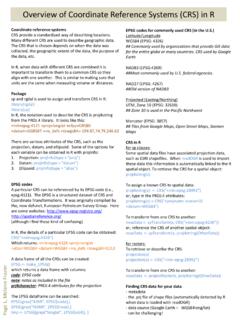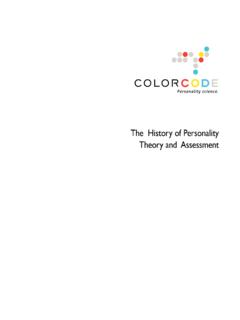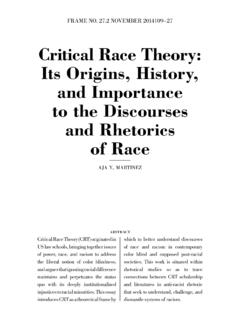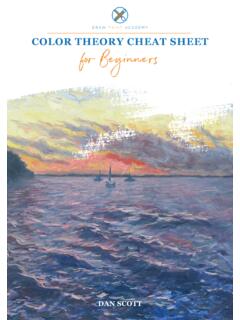Transcription of R color cheatsheet - National Center for Ecological ...
1 Rainbow_hcl(4) "#E495A5" "#ABB065" "#39 BEB1" "#ACA4E2 However, all palettes are fully customizable: diverge_hcl(7, h = c(246, 40), c = 96, l = c(65, 90)) Choosing the values would be daunting. But there are some recommended palettes in the colorspace documentation. There is also an interactive tool that can be used to obtain a customized palette. To start the tool: pal <- choose_palette() R has 657 built in color names To see a list of names: colors() These colors are displayed on P. 3. R color cheatsheet Finding a good color scheme for presenting data can be challenging. This color cheatsheet will help! R uses hexadecimal to represent colors Hexadecimal is a base-16 number system used to describe color .
2 Red, green, and blue are each represented by two characters (#rrggbb). Each character has 16 possible symbols: 0,1,2,3,4,5,6,7,8,9,A,B,C,D,E,F: 00 can be interpreted as and FF as , red= #FF0000 , black=#000000, white = #FFFFFF Two additional characters (with the same scale) can be added to the end to describe transparency (#rrggbbaa) A few notes on HSV/HLC HSV is a better model for how humans perceive color . HCL can be thought of as a perceptually based version of the HSV blah Without delving into color theory : color schemes based on HSV/HLC models generally just look good. R translates various color models to hex, : RGB (red, green, blue): The default intensity scale in R ranges from 0-1; but another commonly used scale is 0-255.
3 This is obtained in R using maxColorValue=255. alpha is an optional argument for transparency, with the same intensity scale. rgb(r, g, b, maxColorValue=255, alpha=255) HSV (hue, saturation, value): values range from 0-1, with optional alpha argument hsv(h, s, v, alpha) HCL (hue, chroma, luminance): hue describes the color and ranges from 0-360; 0 = red, 120 = green, blue = 240, etc. Range of chroma and luminance depend on hue and each other hcl(h, c, l, alpha) peachpuff4 TIP: When it comes to selecting a color palette, DO NOT try to handpick individual colors! You will waste a lot of time and the result will probably not be all that great. R has some good packages for color palettes.
4 Here are some of the options Packages: grDevices and colorRamps grDevices comes with the base installation and colorRamps must be installed. Each palette s function has an argument for the number of colors and transparency (alpha): Package: RcolorBrewer This function has an argument for the number of colors and the color palette (see P. 4 for options). (4, Set3 ) > "#8DD3C7" "#FFFFB3" "#BEBADA" "#FB8072 For the rainbow palette you can also select start/end color (red = 0, yellow = 1/6, green = 2/6, cyan = 3/6, blue = 4/6 and magenta = 5/6) and saturation (s) and value (v): rainbow(n, s = 1, v = 1, start = 0, end = max(1, n - 1)/n, alpha = 1) To view colorbrewer palettes in R: (5) There is also a very nice interactive viewer: Package: colorspace These color palettes are based on HCL and HSV color models.
5 The results can be very aesthetically pleasing. There are some default palettes: ## My Recommendation ## R color Palettes This is for all of you who don t know anything about color theory , and don t care but want some nice colors on your map or ! grDevices palettes rainbow see P. 4 for options (4, alpha=1) > #FF0000FF" "#FF8000FF" "#FFFF00FF" "#FFFF80FF colorspace default palettes diverge_hcl diverge_hsl terrain_hcl sequential_hcl rainbow_hcl R can translate colors to rgb (this is handy for matching colors in other programs) col2rgb(c( #FF0000 , blue )) Page 1, Melanie Frazier Example: Discrete variables R color cheatsheet Overview of colorspace palette selector library("colorspace") pal <- choose_palette() Select the type of color scheme based on the type of data Default color schemes can be used as is or as a starting point for modification Interactively select: hue: color chroma: low chroma = gray luminance: high luminance = pastel power.
6 How the color changes along a gradient Save palette for future R sessions: txt file with hex codes .R file with a function describing how to generate the palette. source can be used to import the function into R; but one complication is that you have to open the .R file and name the function to use it. Copy values into relevant colorspace functions. Diverging color schemes: diverge_hcl(7, h = c(260, 0), c = 100, l = c(28, 90), power = ) Sequential color schemes: sequential_hcl(n, h, c(), l=c(), power) Qualitative color schemes: rainbow_hcl(n, c, l, start, end) (for qualtitative schemes; start/ end refer to the H1/H2 hue values) Display color scheme with different plot types HCL hue How to use hex codes to define color using the plot function When OK is selected, the color palette will be saved in the R session.
7 To return 7 hex color codes from the selected palette: pal <- choose_palette() pal(7) [NOTE: These values are not saved if you don t save the session] Option 1 If you don t need to control which colors are associated with each level of a variable: plot( ~ , col=rainbow_hcl(3)[c(Species)], data=iris, pch=16) legend("topleft", pch=16, col=rainbow_hcl(3), legend=unique(iris$Species)) Option 2 If you want to control which colors are associated with the levels of a variable, I find it easiest to create a variable in the data: iris$ color <- factor(iris$Species, levels=c("virginica", "versicolor", "setosa"), labels=rainbow_hcl(3)) plot( ~ , col= ( color ), pch=16, data=iris) Continuous variables Option 1 Break into categories and assign colors: iris2 <- subset(iris, Species=="setosa") color <- cut(iris2$ , breaks=c(0, , ,2), labels=sequential_hcl(3)) Or, break by quantiles (be sure to include 0 & 1): color <- cut(iris2$ , breaks=quantile(iris$ , c(0, , , , 1)), labels=sequential_hcl(3)) plot( ~ , pch=16, col= color , data=iris2) Option 2 Fully continuous gradient.
8 Data <- ("a"=runif(10000), "b"=runif(10000)) color =diverge_hcl(length(data$a))[rank(d ata$a)] plot(a~b, col= color , pch=16, data=data) Page 2, Melanie Frazier Select # of colors in palette For ggplot2, I think the most flexible color scales are: scale_colour_manual scale_colour_gradient for discrete and continuous variables, respectively code to produce R color chart from: and Page 4, Melanie Frazier Sequential Qualitative Diverging colorRamps and grDevices RColorBrewer Useful Resources: A larger color chart of R named colors: Nice overview of color in R: A color theory reference: Zeileis, A. K. Hornik, P. Murrell. 2009. Escaping RGBland: selecting colors for statistical graphics.
9 Computational and Statistics & Data Analysis 53:3259-3270 To begin interactive color selector: pal <- choose_palette() To display RColorBrewer palette: () For interactive color selector: colorRamps and grDevices color palette, display from: Page 4, Melanie Frazier







